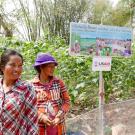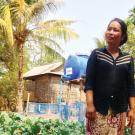This journal article shares findings from effects of conservation agriculture and conservation tillage practices on farmer fields in Cambodia. The article, "Dynamics of Soil Carbon, Nitrogen and Soil Respiration in Farmer’s Field with Conservation Agriculture, Siem Reap, Cambodia," was published in May 2016 in the International Journal of Plant & Soil Science. The article was written by Don Immanuel A. Edralin, Gilbert C. Sigua and Manuel Reyes, as part of the Horticulture Innovation project focused on promoting conservation agriculture for vegetable growers in Cambodia and Nepal.
Abstract
The years of intensive tillage in many countries, including Cambodia, have caused significant decline in agriculture’s natural resources that could threaten the future of agricultural production and sustainability worldwide. Long-term tillage system and site-specific crop management can affect changes in soil properties and processes, so there is a critical need for a better and comprehensive process-level understanding of differential effects of tillage systems and crop management on the direction and magnitude of changes in soil carbon storage and other soil properties. A study was conducted in farmers’ fields to evaluate the effect of conservation agriculture (CA) and conventional tillage (CT) on soil carbon, nitrogen and soil respiration in three villages of Siem Reap, Cambodia. Soil organic carbon (p≤0.01), soil total nitrogen (p≤0.01) and soil respiration (p≤0.10) for at least in two villages were significantly affected by tillage management. The soil quality was improved in villages with CA compared with villages with CT by increasing soil organic carbon (10.2 to 13.3 Mg ha-1) and soil nitrogen (0.87 to 1.11 Mg ha-1) because of much higher soil moisture (15.7±8.6 to 20.0±11.9%) retained in CA and with reduced soil temperature (30.4±2.0 to 32.4±2.3°C) during the dry period. Additionally, field soil respiration was higher in CA (55.9±4.8 kg CO2-C ha-1 day-1) than in CT (36.2±13.5 kg CO2-C ha-1 day-1), which indicates more microbial activity and increased mineralization of soil organic carbon for nutrient release. The soil’s functions of supporting plant growth and sink of carbon and recycler of nutrients was likely improved in agroecosystem with CA than in system with CT. Our results have suggested that CA may have had enhanced soils’ carbon and nitrogen contents, nutrient supplying capacity and microclimate for soil microorganisms in three villages with vegetable production..
Edralin, D. I. A., G.C. Sigua and M. Reyes. 2016. Dynamics of Soil Carbon, Nitrogen and Soil Respiration in Farmer’s Field with Conservation Agriculture, Siem Reap, Cambodia. International Journal of Plant & Soil Science. 11(1): 1-13, 2016. doi:10.9734/IJPSS/2016/25339
If you encounter problems accessing the full text of this journal article, you may contact one of the authors. The corresponding author can be contacted at gilbert.sigua@ars.usda.gov.


